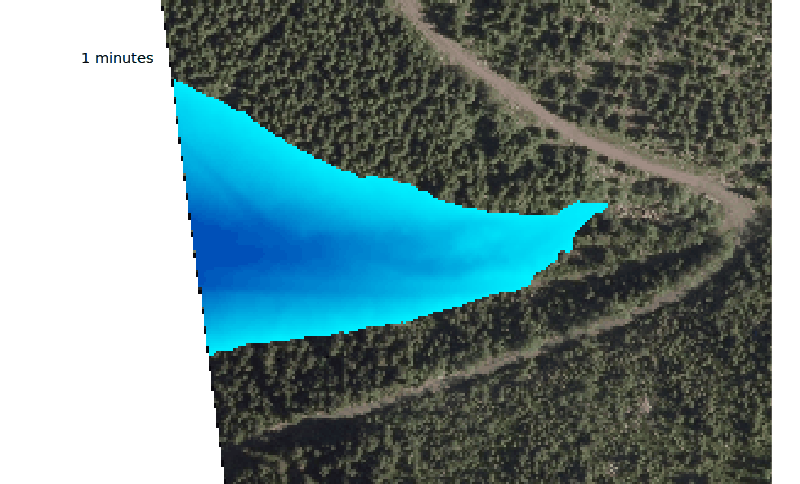Space-time series for flooding simulation¶
In this section we extend our flooding simulation effort performed by r.lake and later automated by graphical modeler and python script. Module r.lake itself allows to generate only one output raster map within one run. This limitation is surpassed by addon r.lake.series (you can install it by g.extension). This module outputs multiple raster maps registered in space-time raster dataset.
r.lake.series elevation=dem37 out=lakes37 start_water_level=990 end_water_level=995 \
water_level_step=0.1 coordinates=531963.147664,5626869.62523 \
time_step=10 nproc=3
In the example above we created space-time series between water levels 990 and 995 with step 0.1 m. Time step is 10 min. To increase computation speed we used three cores. The result is stored in raster space-time dataset named lakes37.
Basic information about output dataset can be obtained by t.info command.
t.info input=lakes37
...
+-------------------- Relative time -----------------------------------------+
| Start time:................. 1
| End time:................... 491
| Relative time unit:......... minutes
| Granularity:................ 10
| Temporal type of maps:...... point
...
+-------------------- Metadata information ----------------------------------+
| Minimum value min:.......... 6.1e-05
| Minimum value max:.......... 0.004822
| Maximum value min:.......... 20.624878
| Maximum value max:.......... 25.524902
| Number of registered maps:.. 50
...
Time topology information can be obtained by t.topology.
t.topology input=lakes37
...
+-------------------- Temporal topology -------------------------------------+
| Temporal topology is: ...... valid
| Number of points: .......... 50
| Number of gaps: ............ 49
| Granularity: ............... 10
...
Space-time Data Querying¶
Using t.list.rast can be printed raster maps within given time period. In the example below are printed raster maps generated within the first hour of flooding simulation.
t.rast.list input=lakes37 order=start_time where="start_time < 60"
name|mapset|start_time|end_time
lakes37_990.0|landa|1|None
lakes37_990.1|landa|11|None
lakes37_990.2|landa|21|None
lakes37_990.3|landa|31|None
lakes37_990.4|landa|41|None
lakes37_990.5|landa|51|None
Univariate statistic can be calculated by t.rast.univar.
t.rast.univar input=lakes37 where="start_time < 60"
id|start|end|mean|min|max|...
lakes37_990.0@landa|1|None|7.00716177683415|0.00018310546875|20.6248779296875|...
lakes37_990.1@landa|11|None|7.03939263446713|0.0001220703125|20.724853515625|...
lakes37_990.2@landa|21|None|7.06764535033695|0.000244140625|20.8248901367188|...
lakes37_990.3@landa|31|None|7.09986937087965|0.00048828125|20.9248657226562|...
lakes37_990.4@landa|41|None|7.13686648936191|0.0018310546875|21.02490234375|...
lakes37_990.5@landa|51|None|7.17042749303603|0.00030517578125|21.1248779296875|...
Data aggregation can be performed by t.rast.aggregate. In the example below data are aggregated by 1 hour.
t.rast.aggregate input=lakes37 output=lakes37_h basename=ag granularity=60 nproc=3
The command generates a new space time dataset which can be used for subsequent analysis like univariate statistics:
t.rast.univar input=lakes37_h
id|start|end|mean|min|max|...
ag_00001@landa|1|61|6.92733335433335|0.00030517578125|20.8748779296875|...
ag_00002@landa|61|121|7.11830269624711|0.0006103515625|21.4748738606771|...
ag_00003@landa|121|181|7.27995970957823|0.00128173828125|22.0748799641927|...
ag_00004@landa|181|241|7.47419607029642|0.0010986328125|22.6748758951823|...
ag_00005@landa|241|301|7.69588708932779|0.000244140625|23.2748819986979|...
ag_00006@landa|301|361|7.92157095217006|0.00115966796875|23.8748779296875|...
ag_00007@landa|361|421|8.13277508575545|0.000244140625|24.4748738606771|...
ag_00008@landa|421|481|8.37088971207057|0.00482177734375|25.0748799641927|...
ag_00009@landa|481|541|8.64080391021424|0.00030517578125|25.4748840332031|...
Space-time Data Extracting¶
Raster spatial-temporal data can be extract into new datasets using t.rast.extract. In the example below will be created three new datasets for first, second and third three hours of flooding.
t.rast.extract input=lakes37 where="start_time > 0 and start_time < 181" output=lakes37_1
t.rast.extract input=lakes37 where="start_time > 180 and start_time < 361" output=lakes37_2
t.rast.extract input=lakes37 where="start_time > 360 and start_time < 541" output=lakes37_3
Aggregation can be done by t.rast.series:
t.rast.series input=lakes37_1 output=lakes37_1_avg method=average
Let’s compute also univariate statistics by r.univar:
r.univar map=lakes37_1_avg
minimum: 0.00128174
maximum: 21.4749
range: 21.4736
mean: 6.74251
...
Space-time Data Visualization¶
Time series can be visualized by specialized tool g.gui.timeline. Example:
g.gui.timeline inputs=lakes37_1,lakes37_2,lakes37_3

Fig. 60 Time visualization of aggregated datasets (first, second, third three hours).
Other interesting tool is g.gui.animation which allows us creating animations. Example:
g.gui.animation strds=lakes37

Fig. 61 GRASS tool for creating animations.

Fig. 62 Example of resultant flooding animation.